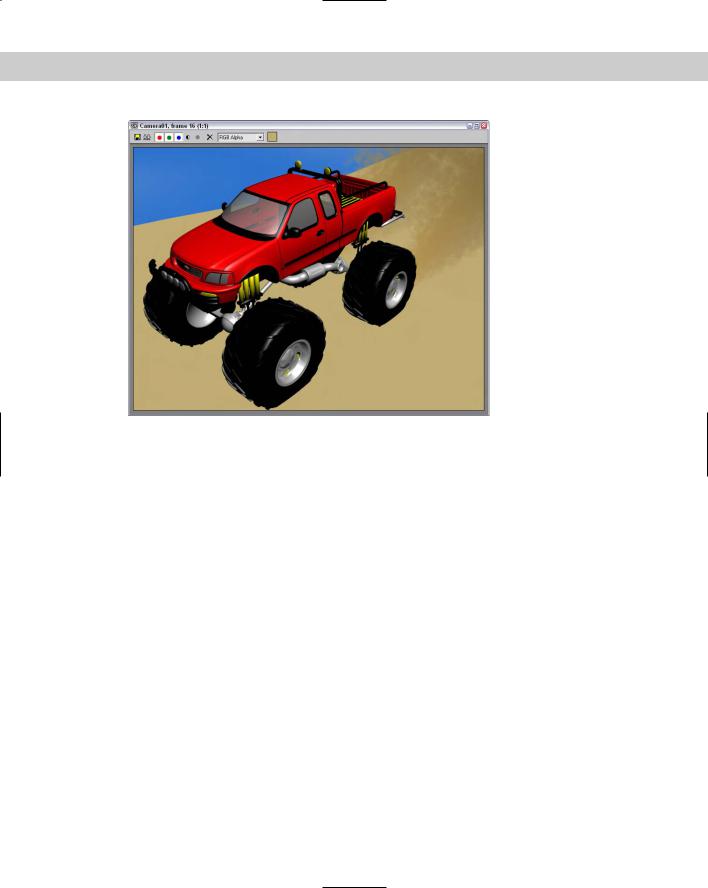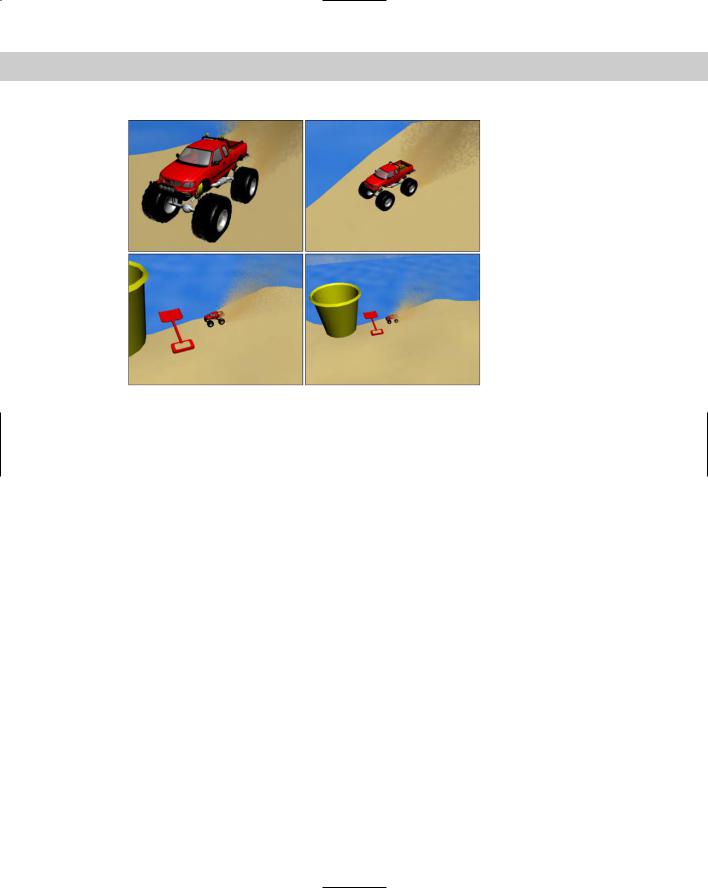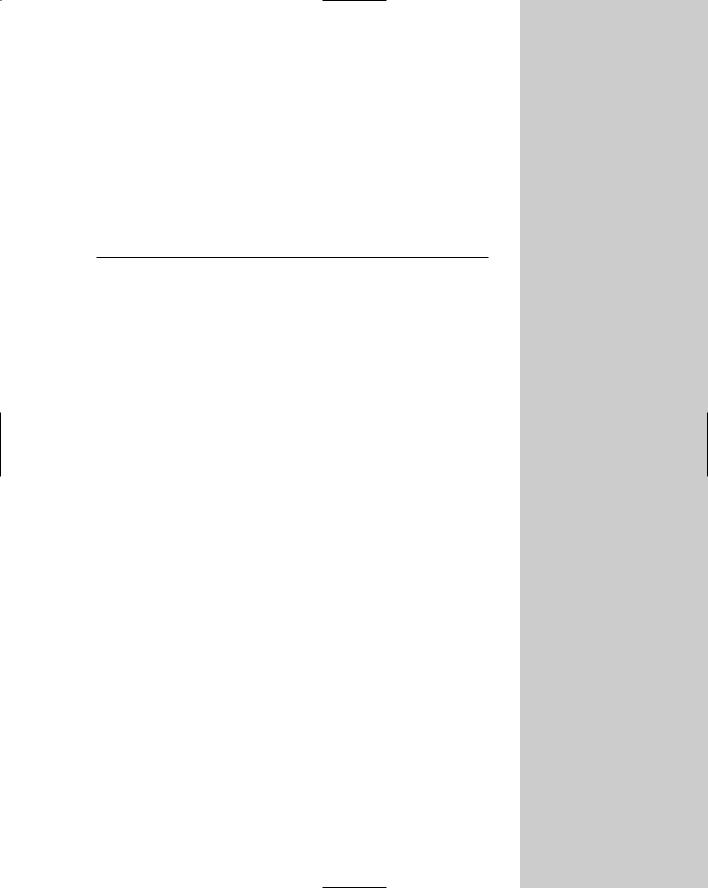
- •Preface
- •About This Book
- •Acknowledgments
- •Contents at a Glance
- •Contents
- •Relaxing at the Beach
- •Dressing the Scene
- •Animating Motion
- •Rendering the Final Animation
- •Summary
- •The Interface Elements
- •Using the Menus
- •Using the Toolbars
- •Using the Viewports
- •Using the Command Panel
- •Using the Lower Interface Bar Controls
- •Interacting with the Interface
- •Getting Help
- •Summary
- •Understanding 3D Space
- •Using the Viewport Navigation Controls
- •Configuring the Viewports
- •Working with Viewport Backgrounds
- •Summary
- •Working with Max Scene Files
- •Setting File Preferences
- •Importing and Exporting
- •Referencing External Objects
- •Using the File Utilities
- •Accessing File Information
- •Summary
- •Customizing Modify and Utility Panel Buttons
- •Working with Custom Interfaces
- •Configuring Paths
- •Selecting System Units
- •Setting Preferences
- •Summary
- •Creating Primitive Objects
- •Exploring the Primitive Object Types
- •Summary
- •Selecting Objects
- •Setting Object Properties
- •Hiding and Freezing Objects
- •Using Layers
- •Summary
- •Cloning Objects
- •Understanding Cloning Options
- •Mirroring Objects
- •Cloning over Time
- •Spacing Cloned Objects
- •Creating Arrays of Objects
- •Summary
- •Working with Groups
- •Building Assemblies
- •Building Links between Objects
- •Displaying Links and Hierarchies
- •Working with Linked Objects
- •Summary
- •Using the Schematic View Window
- •Working with Hierarchies
- •Setting Schematic View Preferences
- •Using List Views
- •Summary
- •Working with the Transformation Tools
- •Using Pivot Points
- •Using the Align Commands
- •Using Grids
- •Using Snap Options
- •Summary
- •Exploring the Modifier Stack
- •Exploring Modifier Types
- •Summary
- •Exploring the Modeling Types
- •Working with Subobjects
- •Modeling Helpers
- •Summary
- •Drawing in 2D
- •Editing Splines
- •Using Spline Modifiers
- •Summary
- •Creating Editable Mesh and Poly Objects
- •Editing Mesh Objects
- •Editing Poly Objects
- •Using Mesh Editing Modifiers
- •Summary
- •Introducing Patch Grids
- •Editing Patches
- •Using Modifiers on Patch Objects
- •Summary
- •Creating NURBS Curves and Surfaces
- •Editing NURBS
- •Working with NURBS
- •Summary
- •Morphing Objects
- •Creating Conform Objects
- •Creating a ShapeMerge Object
- •Creating a Terrain Object
- •Using the Mesher Object
- •Working with BlobMesh Objects
- •Creating a Scatter Object
- •Creating Connect Objects
- •Modeling with Boolean Objects
- •Creating a Loft Object
- •Summary
- •Understanding the Various Particle Systems
- •Creating a Particle System
- •Using the Spray and Snow Particle Systems
- •Using the Super Spray Particle System
- •Using the Blizzard Particle System
- •Using the PArray Particle System
- •Using the PCloud Particle System
- •Using Particle System Maps
- •Controlling Particles with Particle Flow
- •Summary
- •Understanding Material Properties
- •Working with the Material Editor
- •Using the Material/Map Browser
- •Using the Material/Map Navigator
- •Summary
- •Using the Standard Material
- •Using Shading Types
- •Accessing Other Parameters
- •Using External Tools
- •Summary
- •Using Compound Materials
- •Using Raytrace Materials
- •Using the Matte/Shadow Material
- •Using the DirectX 9 Shader
- •Applying Multiple Materials
- •Material Modifiers
- •Summary
- •Understanding Maps
- •Understanding Material Map Types
- •Using the Maps Rollout
- •Using the Map Path Utility
- •Using Map Instances
- •Summary
- •Mapping Modifiers
- •Using the Unwrap UVW modifier
- •Summary
- •Working with Cameras
- •Setting Camera Parameters
- •Summary
- •Using the Camera Tracker Utility
- •Summary
- •Using Multi-Pass Cameras
- •Creating Multi-Pass Camera Effects
- •Summary
- •Understanding the Basics of Lighting
- •Getting to Know the Light Types
- •Creating and Positioning Light Objects
- •Viewing a Scene from a Light
- •Altering Light Parameters
- •Working with Photometric Lights
- •Using the Sunlight and Daylight Systems
- •Using Volume Lights
- •Summary
- •Selecting Advanced Lighting
- •Using Local Advanced Lighting Settings
- •Tutorial: Excluding objects from light tracing
- •Summary
- •Understanding Radiosity
- •Using Local and Global Advanced Lighting Settings
- •Working with Advanced Lighting Materials
- •Using Lighting Analysis
- •Summary
- •Using the Time Controls
- •Working with Keys
- •Using the Track Bar
- •Viewing and Editing Key Values
- •Using the Motion Panel
- •Using Ghosting
- •Animating Objects
- •Working with Previews
- •Wiring Parameters
- •Animation Modifiers
- •Summary
- •Understanding Controller Types
- •Assigning Controllers
- •Setting Default Controllers
- •Examining the Various Controllers
- •Summary
- •Working with Expressions in Spinners
- •Understanding the Expression Controller Interface
- •Understanding Expression Elements
- •Using Expression Controllers
- •Summary
- •Learning the Track View Interface
- •Working with Keys
- •Editing Time
- •Editing Curves
- •Filtering Tracks
- •Working with Controllers
- •Synchronizing to a Sound Track
- •Summary
- •Understanding Your Character
- •Building Bodies
- •Summary
- •Building a Bones System
- •Using the Bone Tools
- •Using the Skin Modifier
- •Summary
- •Creating Characters
- •Working with Characters
- •Using Character Animation Techniques
- •Summary
- •Forward versus Inverse Kinematics
- •Creating an Inverse Kinematics System
- •Using the Various Inverse Kinematics Methods
- •Summary
- •Creating and Binding Space Warps
- •Understanding Space Warp Types
- •Combining Particle Systems with Space Warps
- •Summary
- •Understanding Dynamics
- •Using Dynamic Objects
- •Defining Dynamic Material Properties
- •Using Dynamic Space Warps
- •Using the Dynamics Utility
- •Using the Flex Modifier
- •Summary
- •Using reactor
- •Using reactor Collections
- •Creating reactor Objects
- •Calculating and Previewing a Simulation
- •Constraining Objects
- •reactor Troubleshooting
- •Summary
- •Understanding the Max Renderers
- •Previewing with ActiveShade
- •Render Parameters
- •Rendering Preferences
- •Creating VUE Files
- •Using the Rendered Frame Window
- •Using the RAM Player
- •Reviewing the Render Types
- •Using Command-Line Rendering
- •Creating Panoramic Images
- •Getting Printer Help
- •Creating an Environment
- •Summary
- •Creating Atmospheric Effects
- •Using the Fire Effect
- •Using the Fog Effect
- •Summary
- •Using Render Elements
- •Adding Render Effects
- •Creating Lens Effects
- •Using Other Render Effects
- •Summary
- •Using Raytrace Materials
- •Using a Raytrace Map
- •Enabling mental ray
- •Summary
- •Understanding Network Rendering
- •Network Requirements
- •Setting up a Network Rendering System
- •Starting the Network Rendering System
- •Configuring the Network Manager and Servers
- •Logging Errors
- •Using the Monitor
- •Setting up Batch Rendering
- •Summary
- •Compositing with Photoshop
- •Video Editing with Premiere
- •Video Compositing with After Effects
- •Introducing Combustion
- •Using Other Compositing Solutions
- •Summary
- •Completing Post-Production with the Video Post Interface
- •Working with Sequences
- •Adding and Editing Events
- •Working with Ranges
- •Working with Lens Effects Filters
- •Summary
- •What Is MAXScript?
- •MAXScript Tools
- •Setting MAXScript Preferences
- •Types of Scripts
- •Writing Your Own MAXScripts
- •Learning the Visual MAXScript Editor Interface
- •Laying Out a Rollout
- •Summary
- •Working with Plug-Ins
- •Locating Plug-Ins
- •Summary
- •Low-Res Modeling
- •Using Channels
- •Using Vertex Colors
- •Rendering to a Texture
- •Summary
- •Max and Architecture
- •Using AEC Objects
- •Using Architectural materials
- •Summary
- •Tutorial: Creating Icy Geometry with BlobMesh
- •Tutorial: Using Caustic Photons to Create a Disco Ball
- •Summary
- •mental ray Rendering System
- •Particle Flow
- •reactor 2.0
- •Schematic View
- •BlobMesh
- •Spline and Patch Features
- •Import and Export
- •Shell Modifier
- •Vertex Paint and Channel Info
- •Architectural Primitives and Materials
- •Minor Improvements
- •Choosing an Operating System
- •Hardware Requirements
- •Installing 3ds max 6
- •Authorizing the Software
- •Setting the Display Driver
- •Updating Max
- •Moving Max to Another Computer
- •Using Keyboard Shortcuts
- •Using the Hotkey Map
- •Main Interface Shortcuts
- •Dialog Box Shortcuts
- •Miscellaneous Shortcuts
- •System Requirements
- •Using the CDs with Windows
- •What’s on the CDs
- •Troubleshooting
- •Index

18 |
Part I Learning the Max Interface |
Figure QS-11: Particles can be used to simulate dust and smoke effects.
Rendering the Final Animation
Rendering the final animation can take lots of time, depending on the output resolution and the power of your computer. The final output is started through the Render Scene dialog box, which you can open with the Rendering Render menu command (or by pressing the F10 key). The Render Scene dialog box offers several options for customizing the output, but before we render the final output, let’s create a preview animation to make sure that everything looks okay.
Tutorial: Creating a preview animation
Before we render the final scene, it is a good idea to produce a Preview animation. Doing so helps to eliminate some problems before the time is spent rendering the entire animation. The Preview is simply the viewport scene stitched together into an animation. The shading options are the same as those available for the viewports.
To create a Preview animation, follow these steps:
1.With the Camera01 viewport active, choose Animation Make Preview. The Make Preview dialog box appears, as shown in Figure QS-12.
2.In the Make Preview dialog box, you can select the Active Time Segment, which includes all frames in the animation. Set the Image Size to 50 percent, and select the AVI Output option. In the Display in Preview section, make sure to check the Geometry, Lights, and Background check boxes. Select Camera01 as the Render Viewport.

Chapter QS Quick Start: Animating a Monster Truck at the Beach |
19 |
Figure QS-12: The Make Preview dialog box can produce a quick look at your animation sequence.
3.Click the Create button.
Max begins the rendering, opens the default Media Player when finished, and plays the preview.
4.Choose Animation View Preview to view the preview again, if desired.
As you look at the preview, notice that the material maps and render scaled planes aren’t included in the preview, but you can watch for the following types of errors:
Objects moving through one another
Insufficient lighting
Erratic object (non-smooth) motion
Tutorial: Rendering the final animation
After you’ve fixed all the errors and you’re comfortable with the Preview animation, you can open the Render Scene dialog box and prepare your final animation for rendering.
To view the final animation rendering settings, follow these steps:
1.Open the Render Scene dialog box, shown in Figure QS-13, by choosing Rendering Render (or by pressing F10).
2.In the Time Output section, select Active Time Segment. In the Output Size section, select 320×240 as the resolution.

20 |
Part I Learning the Max Interface |
Figure QS-13: The Render Scene dialog box includes many diverse rendering settings.
3.Next, we’ll save the rendered scene to a file. In the Render Output section, click the Files button to open the Render Output File dialog box. Select the location to save the file, enter the name Monster truck at beach, and from the Save as type drop-down list, select .AVI as the format. Click Save.
Tip |
If you don’t want to save the file, you can render the scene to the Rendered Frame Window. |
|
After the rendering is complete, you can save the animation by clicking the Save Bitmap but- |
|
ton. The Rendered Frame Window can save animation and bitmap formats. |
The Video Compression dialog box appears.
4.Select the Cinepak Codec by Radius Compressor with a Quality setting of 100 and a Key Frame every 15 frames. Click OK to continue.
5.Back in the Render Scene dialog box, check the viewport setting at the bottom of the dialog box and make sure that Camera01 is selected. Then click the Render button to start the rendering process.
Figure QS-14 shows some frames from the final animation. This final tutorial is saved as Final render.max.
We could do much more to this animation, such as using lens effects or adding a motion blur, but I wanted to save some effects for the rest of the book. Feel free to load and modify this simple animation as you desire.

Chapter QS Quick Start: Animating a Monster Truck at the Beach |
21 |
Figure QS-14: Four frames from the final animation of our monster truck playing in the sand
With the Quick Start completed, you’re ready to dive into the features of Max, beginning with Chapter 1, “Finding Your Way — Exploring the Max Interface.”
Summary
I hope you’re happy with your first footsteps into Max. This chapter exposed you to a number of important aspects of Max, including
Creating background elements and merging objects
Applying materials to scene objects
Simple modeling of objects and using modifiers
Loading a background image for the scene
Animating objects with keyframes
Adding and animating a camera
Creating special effects like dust using a particle system
Rendering a preview and the final animation
But hold onto your seats because so much of the software lies ahead. In the first chapter, you start easily with an in-depth look at the Max interface. If you feel ready for more advanced challenges, review the Table of Contents and dive into any topic that looks good.
|
|
|


Finding Your Way —
Exploring the Max
Interface
Well, here we are with a new version of Max, and the first question on the minds of existing users is “Did the interface
change?” The answer is a gleeful “not much.” Most serious users would rather go through root canal surgery than have their user interface (UI) change, and although Discreet has learned and respected this valued opinion, you’ll find some minor changes.
As you look around the new interface, you’ll see that everything is still there, but Max has several clever, new additions. You may find yourself saying, as you navigate the interface, “where did that come from?” But, just like encountering a new house in your neighborhood, over time you’ll become accustomed to the addition and might even meet some new friends.
Why is the software interface so important? Well, consider this: The interface is the set of controls that enables you to access the program’s features. Without a good interface, you may never use many of the best features of the software or spend a frustrating bit of time locating it. A piece of software can have all the greatest features, but if the user can’t find or access them, then the software won’t be used to its full potential. Max is a powerful piece of software with some amazing features, and luckily, the interface makes these amazing features easy to find and use.
The interface is all about making the features accessible, and in Max you have many different ways to access the same command. Some of these access methods are faster than others. This design is intentional because it gives beginning users an intuitive command and advanced users direct access. For example, to undo a command, you can choose Edit Undo (requiring two mouse clicks), but as you gain more experience, you can simply click the Undo icon on the toolbar (only one click); an expert with his hands on the keyboard will press Ctrl+Z without having to reach for the mouse at all. All three of these methods have the same result, but you can use the one that is easiest for you.
Has the Max interface succeeded? Yes, to a degree, but like most interfaces, it always has room for improvement, and we hope that
C 1H A P T E R
In This Chapter
Learning the interface elements
Previewing the menu commands
Becoming familiar with the toolbars
Using the Command
Panel
Examining the Lower
Interface Bar
Interacting with the interface
Getting help
